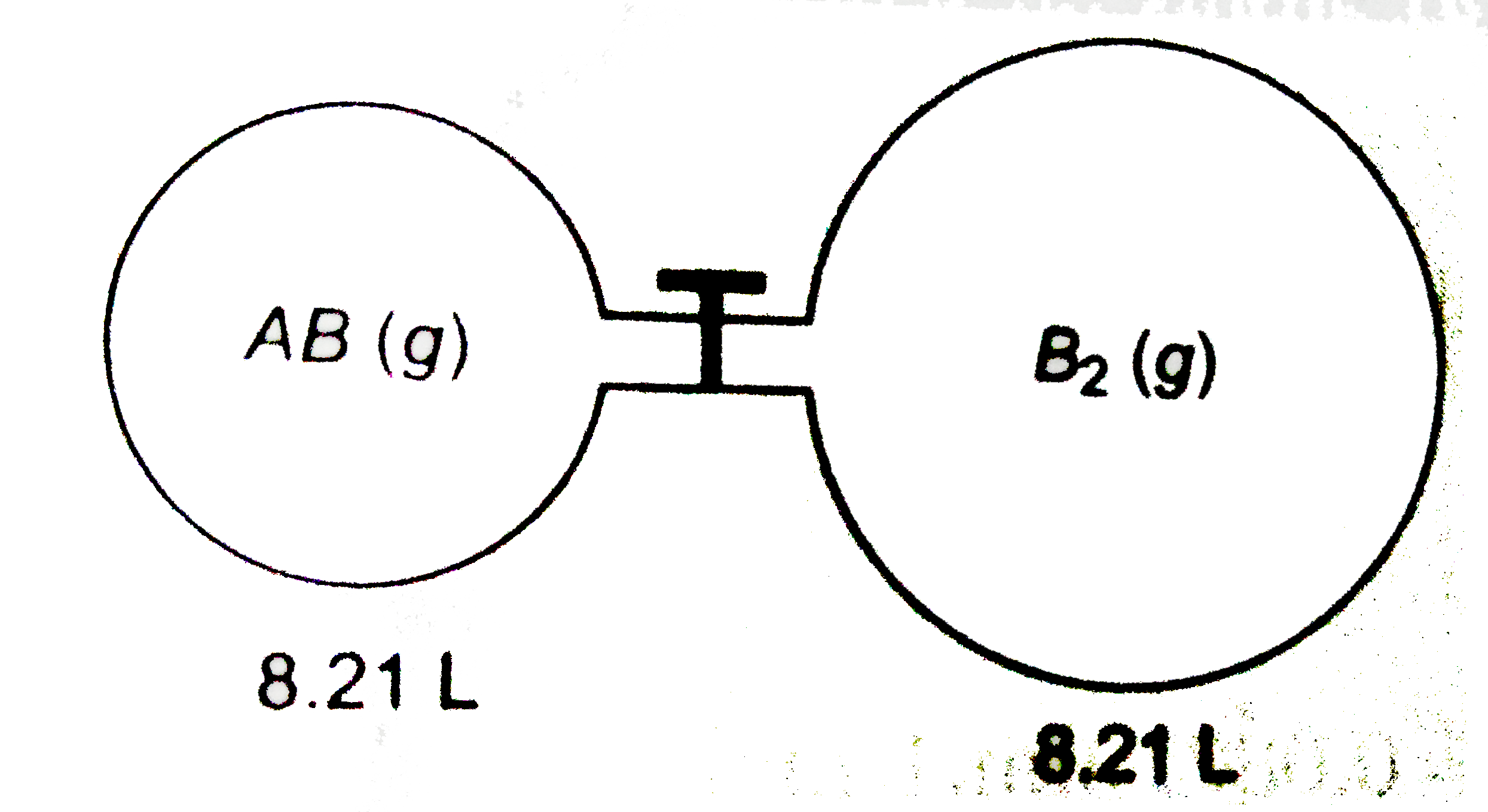At room temperature, the following reaction proceeds nearly to completion:
2NO+O2→2NO2→N2O4
The dimer, N2O4, solidfies at 262K. A 250mL flask and a 100mL flask are separated by a stopcock. At 300K, the nitric oxide in the larger flask exerts a pressure of 1.053atm and the smaller one contains oxygen at 0.789atm. The gase are mixed by opening the stopcock and after the end of the reaction the flasks are cooled to 220K. Neglecting the vapour pressure of the dimer, find out the pressure and composition of the gas remaining at 220K. (Assume the gases to behave ideally)
The correct Answer is:( 0.221 atm )
First we calculate partial pressure of NO and O2 in the combined system when no reaction takes place.
p V = constant ⇒p1V1=p2V2
⇒p2(NO)=1.053×250350=0.752 atm, p2(O2)=0.789×100350=0.225 atm
Now the reaction stoichiometry can be worked out using partial pressure because in a mixture. pi∝n1
2NO+O2→2NO2→N2O4
Initial0.752atm0.225atm00Final0.302000.225atm
Now, on cooling to 220 K, N2O4 will solidify and only unreacted NO will be remaining in the flask.
∵p∝T p1p2=T1T2⇒0.302p2=300220⇒p2(NO)=0.221 atm
Similar Questions
At room temperature, the following reaction proceeds nearly to completion:
2NO+O2→2NO2→N2O4
The dimer, N2O4, solidfies at 262K. A 250mL flask and a 100mL flask are separated by a stopcock. At 300K, the nitric oxide in the larger flask exerts a pressure of 1.053atm and the smaller one contains oxygen at 0.789atm. The gase are mixed by opening the stopcock and after the end of the reaction the flasks are cooled to 220K. Neglecting the vapour pressure of the dimer, find out the pressure and composition of the gas remaining at 220K. (Assume the gases to behave ideally)
View SolutionAt room temperature following reaction goes to cormpletion 2NO+O2→2NO2→N2O4
Dimer N2O2 at 262K is solid. A 250 ml flask and a 100 ml flask are separated by a stop cock. At 300 K, the nitric oxide in the larger flask exerts a pressure of 1.053 atm and the smaller one contains O2 at 0.789 atm. The gases are mixed by opening the stop cock and after the. end of the reaction, the flasks are cooled to 220 K. Neglecting the vapour pressure of dimer find out the pressure and composition of gas remaining at 220 K. (Assume gases behave ideàlly).
View Solution
Knowledge Check
At room temperature following traction goes to completion
2AB(g)+B2(g)→2AB2(s)
AB2 is solid with negligble vapour pressure below 0∘C. At 300 K, the AB in the smaller flask exerts a pressure of 3 atm and in the larger flask B2 exerts a pressure of 1 atm at 400 K when they are separated out by a close valve, The gases are mixed by opening the stop cock and after the end of the reaction the flask are cooled to 250 K

The final pressure is :A0.156 atmB0.3125 atmC0.625 atmD3.2 atmIn the following figure, when the two stopcocks are opened, the total pressure inside the flask will be
 A1.41 atmB2.41 atmC3.41 atmD1.12 atm
A1.41 atmB2.41 atmC3.41 atmD1.12 atmAn open flask contains air at 27∘ C and one atm. Pressure. The flask is heated to 127∘ C at the same pressure . The fraction of original air remaining in the flask will be
A15B25C12D34
A gaseous mixture containing 8g of O2 and 227 mL of N2 at STPis enclosed in flask of 5 L capacity at 0∘C. Find the partial pressure of each gas and calculate the total pressure in the vessel.
View SolutionTwo gases in adjoining vessels were brought into correct by opening a stopcock between them. The one vessel measured 0.25L and contained NO gas at 800 torr and 220K, the other measured 0.1L contained O2 gas at 600 torr and 220K. The reaction to form N2O4(s) exhausts the limiting reagent completely,
(a) Neglacting the vapour pressure of N2O, what is the pressure of the gas remaining at 220K after complection of the reaction?
(b) What weight of N2O is formed?
View SolutionN2 is found in a litre flask under 100kPa pressure and O2 is found in another 3litre flask under 20KPa pressure. If the two flask are connected, the resultant pressure is
View SolutionWhen two gases A and B of 20 ml and 40 ml each are added to 40 ml flask at a pressure of 1 atm and 2 atm respectively. Find the Value of Kp if 10 ml of gas C is formed at an equilibrium pressure of 2.25 atm (Assume A, B and C are ideal gases).
View SolutionN2 is found in a litre flask under 100 kPa pressure and O2 is found in another 3 litre flask under 320 kPa pressure. If the two flasks are connected, the resultant pressure is
View Solution

